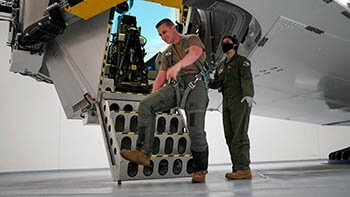 U.S. Air Force Staff Sgt. Joe Pick, 1st Combat Camera Squadron, exits the centrifuge at the 711th Human Performance Wing, Wright-Patterson Air Force Base, Dayton, Ohio, April 5, 2021.
U.S. Air Force Staff Sgt. Joe Pick, 1st Combat Camera Squadron, exits the centrifuge at the 711th Human Performance Wing, Wright-Patterson Air Force Base, Dayton, Ohio, April 5, 2021.
Training Includes Centrifuges
In the Air Force, undergraduate pilots begin flight training on the T-6 single prop airplane - so they can experience moderate G-forces.
The next step is the T-38 trainer for fighter aircraft. Before pilots can train in that aircraft they go to AFRL in Dayton for tests of exposure to severe G-forces at the only DOD human-rated centrifuge.Wright Patterson News
The centrifuge can produce up to nine Gs, or nine times the normal force of gravity, to measure the student's ability to counteract the effects of G-forces to prevent GLOC.
Jet aviators must be able to sustain sudden changes in pressure and altitude at speeds approaching or exceeding the speed of sound and gravitational forces up to nine times the normal pull (9Gs). If an Air Force student aviator is assigned to F-15s, F-16s, F-22s or F-35s, they go back to Wright-Patterson AFB for more centrifuge training qualification.
Naval aviators get centrifuge testing at Brooks City Base in San Antonio, Texas. That centrifuge can produce more than seven-and-a-half Gs with various onset rates, Welsh said.
Both the Air Force and Navy also have a "low fidelity simulator" that connects an aviator's oxygen mask to a box "that scrubs oxygen out of the air they're breathing, and increases the amount of nitrogen they're breathing. They become hypoxic, meaning they lack of adequate oxygen levels to perform," Welsh explained. The pilots learn emergency procedures to overcome various physiological episodes that could cause incapacitation.
Water Survival Training
The highest risk training done by the Navy is water survival training, Welsh said. That is a whole day of learning how to prevent panic and to stay calm in extreme situations. "The primary objective of our water survival training is water comfort and controlling your fear," Welsh said.
In the water, instructors flip aviators upside down, blindfold them in a dunker while they're in their full gear – flight suits, boots, survival helmets, and a life preserver. The aviators also learn swimming strokes, and how to hold on to reference points.
One of the most difficult training drills is when their life preserver fails to inflate, Welsh said. In that situation, the pilots have to tread water with all their gear on and manually inflate the life preserver.
Nutrition and Exercise to Optimize Performance
The military trainers teach aviators about proper nutrition and exercise to optimize performance.
"Much like maintaining an aircraft, it's maintaining your body," Welsh said.
"If you don't give your body the proper amount of fuel, the right types of fuel, meaning calories, or the right types of food groups," pilots' bodies will not be able to stand up to a barrage of high G-force maneuvers, he said.
Low blood glucose levels can also impact G-force performance, Sauls said. Proper hydration and enough sleep to combat fatigue are also necessary, because human factors are the biggest cause for aviation mishaps, Welsh said.
The Air Force relies on lower body and core strength training. That means "we're going to think heavier weight, lower repetitions. Things like squats, lunges, and deadlifts really build up that base, improve that frame," Sauls said.
"And then from a cardiovascular standpoint, to best mirror the operational environment, we would lean more toward high-intensity interval training, sprint intervals, circuit training, only get a heart rate up for a short period, then rest and repeat."
Some bases are now hiring dietitians and conditioning coaches, Sauls added. The 19th Air Force19th Air Force at Joint Base San Antonio-Randolph, which oversees Air Force pilot training, has created formal instruction on how pilots can improve their diet and exercise.
The Army Aviation Center of ExcellenceArmy Aviation Center of Excellence is the Army Aviation Branch's training and development center, located at Fort Rucker, Alabama.
USAACE trains and develops "agile and adaptive" Army aviators, manages the aviation enterprise, and "integrates aviation capabilities and requirements across the warfighting functions to enable commanders and soldiers on the ground to fight and win in an increasingly complex world."